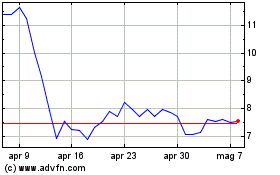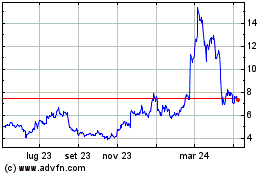Bitcoin Mining Difficulty Hits All-Time High For The 4th Time In 2023: Here’s Why
08 Aprile 2023 - 11:57AM
NEWSBTC
Bitcoin mining difficulty continues to break records despite the
struggles of BTC to surpass the $30,000 resistance mark. The
leading coin has attracted the interest of miners in recent months
due to the price recovery experienced since the turn of the
year. Bitcoin Mining Difficulty Hits New Record Bitcoin
mining difficulty moved to an all-time high on April 6, 2023,
following the most recent mining difficulty adjustment on its
blockchain network. The mining difficulty rose for the fourth
consecutive time and reached 47.8 trillion, an increase of
2.3%. The Bitcoin mining difficulty automatically adjusts
every 2,016 blocks – approximately two weeks – to maintain the
10-minute block creation time. There has been a steady increase in
mining difficulty in recent weeks, with the last downward trend
recorded on February 11. One of the consequences is reflected
in the hash price, which is the rate of profit miners make for the
hashrate they provide to the Bitcoin network. In theory, a higher
mining difficulty leads to a lower hash price. This is because more
miners are contributing computing power than normal, leading to
more competition for the rewards that the Bitcoin network provides
miners that produce new blocks on the network. Related Reading:
Buckle Up! Bitcoin Bollinger Bands Signal An Impending
Rollercoaster Ride Furthermore, the Bitcoin hashrate or processing
power can indicate the degree of mining difficulty. At the time of
the mining difficulty adjustment that preceded the latest one,
BTC’s hash rate was at a record high leading to increased mining
difficulty. However, this has changed recently, with the
hashrate falling by an average of 20 EH/s this week. It should be
noted that Bitcoin’s hashrate varies as measured by different
sources. For example, BTC.com places the metric at 338 EH/s, and
mempool places this at a slightly higher metric of 347/ EH/s
Bullish Market A Major Reason For Increased Mining Difficulty
Bitcoin has appreciated by more than 50% since the start of 2023,
leading to calls for a bullish market. Unsurprisingly this positive
trend has led to many miners reconnecting their equipment after a
difficult 2022. Related Reading: Uniswap Who? Trader Joe’s
AMM Takes DeFi By Storm The collapse of Terra Luna and subsequent
fallout from FTX led to significant bearish pressure on the market,
with several coins taking steep price declines. Bitcoin was one of
the coins to dip, leading to a difficult year for miners, with many
having to sell their equipment or shut down operations to stay
afloat. However, the bull run of 2023 has raised expectations
from miners that the market could be on its way to previous levels.
Nonetheless, the crypto mining sector has not been without its
difficulties, with friendly places like Texas in the United States
planning to tighten regulations on electricity that could affect
the booming sector soon. Featured image from unsplash, charts
from mempool and Tradingview.com
Grafico Azioni Uniswap (COIN:UNIUSD)
Storico
Da Mar 2024 a Apr 2024

Grafico Azioni Uniswap (COIN:UNIUSD)
Storico
Da Apr 2023 a Apr 2024
